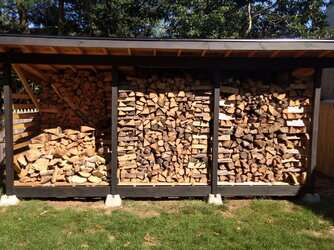Hello -
I am running a VC Intrepid, new as of last year with double walled pipe to the top of the 9' ceiling and 9' more of triple walled insulted pipe. There is a bend in the double walled pipe to get it away from the chimney peak.
This is my second year running this VC and third year with a wood stove. I'm burning wood that I know is not <25% moisture (still working to get ahead) but I burn consistently over 400 degrees 24/7. I clean my chimney out each year and leave it ready for the upcoming season. I have some creosote build up on the glass (what I believe is a sign of poor burning) but not too much and only needing a cleaning every couple of weeks. This may be a lot, but it's less frequent than my previous two years which tells me I'm burning better than in the past.
I've experienced over the past few weeks frequent (every few days) but small (out within <5 minutes after closing the bypass) chimney fires. What seems to be happening is I load the stove up with a few pieces of wood, leave the air opening on high to get a fire going, and then the fire leaps up and then goes straight from the box into the chimney and starts a chimney fire. These have only happened when I'm warming up the stove and never during an overnight burn even with the bypass open. I never leave the air on high overnight.
I understand that burning clean wood is the most important thing and I've taken steps to improve my wood quality. Over the past week, I've burning almost exclusively kiln dried wood but still had a chimney fire. Other than improving my wood quality, is there anything that would lead to this happening so frequently? As noted, this is not my first year and definitely the highest quality of wood burned yet, however the fires seem to be getting more frequent. I haven't inspected my flue since I fired it up but I did this fall when I cleaned it and everything looked fine. Is the only way to prevent this to ensure I use high quality wood and always burn via the catalytic converter?
Thanks in advance.
I am running a VC Intrepid, new as of last year with double walled pipe to the top of the 9' ceiling and 9' more of triple walled insulted pipe. There is a bend in the double walled pipe to get it away from the chimney peak.
This is my second year running this VC and third year with a wood stove. I'm burning wood that I know is not <25% moisture (still working to get ahead) but I burn consistently over 400 degrees 24/7. I clean my chimney out each year and leave it ready for the upcoming season. I have some creosote build up on the glass (what I believe is a sign of poor burning) but not too much and only needing a cleaning every couple of weeks. This may be a lot, but it's less frequent than my previous two years which tells me I'm burning better than in the past.
I've experienced over the past few weeks frequent (every few days) but small (out within <5 minutes after closing the bypass) chimney fires. What seems to be happening is I load the stove up with a few pieces of wood, leave the air opening on high to get a fire going, and then the fire leaps up and then goes straight from the box into the chimney and starts a chimney fire. These have only happened when I'm warming up the stove and never during an overnight burn even with the bypass open. I never leave the air on high overnight.
I understand that burning clean wood is the most important thing and I've taken steps to improve my wood quality. Over the past week, I've burning almost exclusively kiln dried wood but still had a chimney fire. Other than improving my wood quality, is there anything that would lead to this happening so frequently? As noted, this is not my first year and definitely the highest quality of wood burned yet, however the fires seem to be getting more frequent. I haven't inspected my flue since I fired it up but I did this fall when I cleaned it and everything looked fine. Is the only way to prevent this to ensure I use high quality wood and always burn via the catalytic converter?
Thanks in advance.


